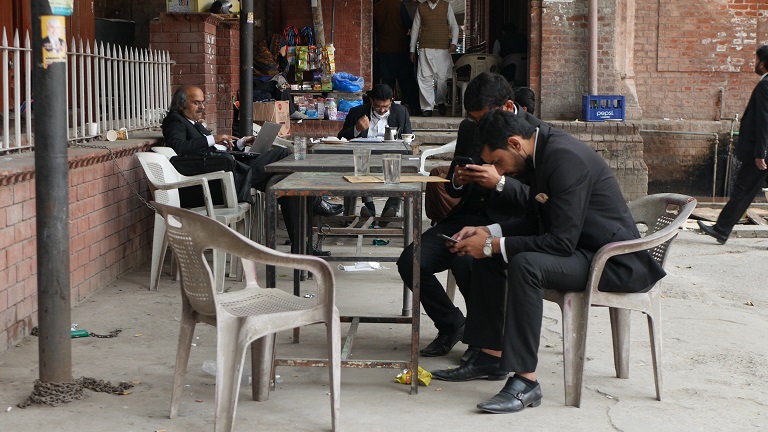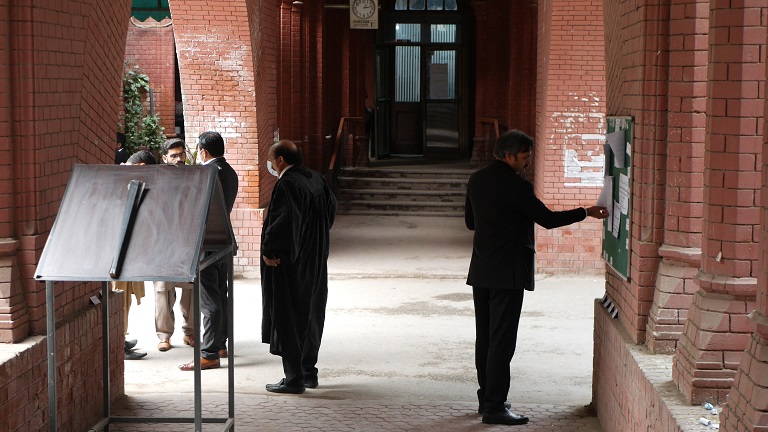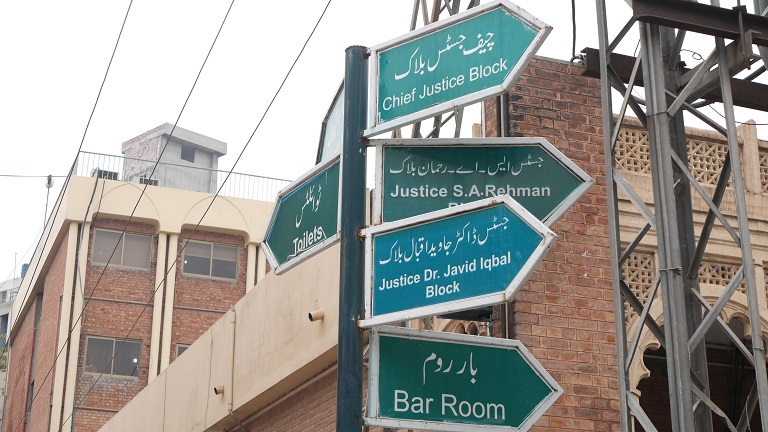Justice Ayesha A Malik has become the first woman to be appointed as a Supreme Court judge in Pakistan. Her elevation to the apex court, though, has been a contentious one. Its opponents disapprove of the procedure through which she has been appointed while its proponents claim that the opposition she is facing is merely aimed at hindering the women’s inclusion in the higher judiciary.
The dispute began in September 2021 when the then Chief Justice of Pakistan, Justice Gulzar Ahmed, suggested her name to the Judicial Commission of Pakistan as a candidate. She was then a judge at the Lahore High Court. Subsequent to this suggestion, Abdul Latif Afridi, the then president of the Supreme Court Bar Association, called for a countrywide protest of lawyers against it.
The controversy continued within the Judicial Commission of Pakistan as well. One of its members and a Supreme Court Judge, Justice Qazi Faiz Issa, was out of Pakistan at the time; thus, eight of its nine members were left to decide on Malik’s appointment. Out of these, four members supported her appointment and four opposed it; hence, she could not be elevated to the Supreme Court.
Justice Maqbool Baqar, Justice Sardar Tariq Masood, former judge Dost Mohammad Khan and a representative of the Pakistan Bar Council, Akhtar Hussain, were among those who opposed her appointment. They stated that three senior high court judges were already in line for the elevation and to supersede them by nominating Justice Malik, who was junior to them, was unfair.
On the other hand, Justice Gulzar Ahmed, Justice Umar Ata Bandial, Federal Law Minister Barrister Farogh Naseem and Attorney General Khalid Jawed Khan supported her appointment. They argued that her appointment would set an encouraging precedent for women to join the legal profession.
Earlier this year, Justice Gulzar Ahmed recommended her name again to the Judicial Commission of Pakistan. This time, all the members of the commission were present in the meeting that considered her elevation. Retired Justice Dost Mohammad, however, was replaced by former Supreme Court judge, Sarmad Jalal Usmani. The change favoured Justice Malik as five of the nine members of the commission supported her appointment. Its proponents included Justice Ahmed, Justice Bandial, retired Justice Usmani, Law Minister Naseem and Attorney General Khan. The opposition to her appointment came from Justice Issa, Justice Baqar, Justice Masood and Pakistan Bar Council (PBC) representative, Hussain.

A parliamentary committee, subsequently, endorsed her elevation on January 19th, 2022. Its chairman, Senator Farooq H Naek, however, contended that the committee believed that the principle of seniority should be followed for the appointment of judges to the Supreme Court but Justice Malik, despite being the fourth most senior judge in the Lahore High Court, was being recommended for the post “in national interest.” This, he said, was done because it would pave the way for the first woman to become a Supreme Court judge.
Nida Usman Chaudhary, founder of a non-government organization, Women in Law Initiative Pakistan, on the other hand claims that the opposition to Justice Malik’s elevation was the manifestation of a misogynistic attitude. She also contends that seniority is not a requirement at all for the appointment of judges in the Supreme Court. “Seniority is only a factor in the appointment of the Chief Justice of Pakistan,” she says. For any other vacancy in the higher courts, she argues, the law and constitution make no reference that only the senior most judges be nominated to fill it. “The bar has been misleading people into believing that some sort of ‘principle’ has been ‘violated’ with her appointment when none actually exists,” she says.
Usama Khawar, a lawyer and a part-time teacher at the Lahore University of Management Sciences (LUMS), does not agree with her. He says, “Even if we accept that the seniority principle does not exist, it will be wrong to say that the legal community was opposing an out of turn elevation for the first time”. According to him, the opposition to such postings has been gathering momentum for a number of years and it has never had anything to do with a nominee’s gender.
Controversies galore
In the last few years, there have been several controversies over the appointment of Supreme Court judges. In 2010, for instance, Chief Justice of Pakistan, Justice Iftikhar Muhammad Chaudhary, appointed Lahore High Court Chief Justice Khawaja Muhammad Sharif as a judge of the Supreme Court. He, however, refused to accept the decision. As a result, Justice Mian Saqib Nisar and Justice Asif Saeed Khosa were appointed as judges of the Supreme Court although they were both junior to Justice Sharif.
Similarly, Justice Munib Akhtar was appointed as a judge of the Supreme Court in May 2018 on the recommendation of the then Chief Justice Nisar, even though he ranked fourth among the Sindh High Court judges in terms of seniority. Lawyers protested against his appointment strongly. The representatives of the Sindh Bar Council publicly condemned it at a press conference and called it a violation of the superior judiciary’s own previous judgements.
Such controversial appointments continued under Chief Justice Khosa. For example, he recommended the appointment of Justice Qazi Muhammad Amin to the Supreme Court in April 2019 even though he was ranked 26th in seniority as a judge of the Lahore High Court and had also retired a month ago. In October the same year, Justice Aminuddin Khan was appointed a judge of the Supreme Court despite ranking fifth in the seniority list of the Lahore High Court.
Former Chief Justice of Peshawar High Court Waqar Seth had, indeed, filed a petition in 2020 saying that he had been superseded thrice as Justice Amin, Justice Khan and Justice Sayyed Mazahar Ali Akbar Naqvi were appointed to the Supreme Court out of turn. His plea was yet to be heard by the court when he contracted Coronavirus and died in November the same year.
Likewise, two women judges were also superseded in the past for appointment to the Supreme Court. They were among those five women whom Benazir Bhutto, the then prime minister, had appointed as high court judges in 1994 for the first time in the history of Pakistan. From among these, Justice Fakhr-un-Nisa Khokhar, Justice Talat Yaqoob and Justice Nasira Iqbal were appointed in the Lahore High Court and Justice Majida Rizvi and Justice Khaleda Rashid Khan were appointed in Sindh High Court and Peshawar High Court respectively.

General Pervez Musharaf failed to add any female judge in the superior courts. On the contrary, when Justice Khan was qualified to become the Chief Justice of the Peshawar High Court or a judge of the Supreme Court in 2003, she was denied either of the two positions. She was, instead, prompted to join the International Criminal Tribunal on Rwanda. Similarly, Justice Khokhar was at one stage the senior-most judge of the Lahore High Court and, therefore, was next in line to become either the Chief Justice of the high court or be elevated to the Supreme Court. But she was prevented from taking up her rightful post and was, instead, replaced by a male judge.
Seniority versus competence
When Justice Abdul Rashid retired as the first chief justice of Pakistan in 1954, the governor general at the time, Ghulam Muhammad, was not in favour of appointing the next senior judge, ASM Akram, to the post vacated by him. Akram had served as the first Chief Justice of the Dacca High Court and later as a judge of the Federal Court of Pakistan. Muhammad instead exercised his authority as per the Government of India Act, 1935, and hand-picked Muhammad Munir, chief justice of the Lahore High Court, as the Chief Justice of Pakistan.
When the first constitution of Pakistan was enacted in 1956, it empowered the head of state – the President of Pakistan – to make appointments to the high judiciary just as the Government of India Act 1935 had done before that. This power was retained in the 1962 constitution adopted under General Ayub Khan. Some changes, however, were made under the 1973 Constitution. While the Chief Justice of Pakistan was still to be appointed by the President, the rest of the Supreme Court judges were to be appointed by the President in consultation with the Chief Justice of Pakistan.
A dispute, however, arose between the then prime minister Benazir Bhutto and the then president Ghulam Ishaq Khan as to who exactly held the power to appoint judges. The issue was later taken to the Lahore High Court by a lawyer, M.D. Tahir, who filed a petition there in order to resolve the ambiguity.
Lahore High Court declared that Article 193 of the Constitution did not mention the role of the prime minister with regard to judicial appointments. This decision was challenged by Benazir Bhutto’s government in the Supreme Court. Hamid Khan, a renowned jurist, states in his book, The Constitutional and Political History of Pakistan, the government withdrew its appeal under pressure from President Ghulam Ishaq Khan. The conflict, thus, remained unresolved.
A few years later, in 1994, when Chief Justice of Pakistan, Dr Nasim Hasam Shah retired, Justice Saad Saud Jan was next in line in terms of seniority to take the post. But the government superseded three senior judges, including Jan, and appointed Syed Sajjad Ali Shah as the Chief Justice of Pakistan. An organization called Al-jihad Trust would soon challenge his appointment through a petition at the Supreme Court.
While deciding this case, the Supreme Court made it binding upon the President that he cannot ignore the advice of the Chief Justice of Pakistan in any judicial appointment. Two years later, in a case known as Malik Asad Ali versus the Federation of Pakistan, the Supreme Court also ruled that Justice Shah’s appointment was unconstitutional since it violated the seniority principle.
These conflicts show that no clear criterion has ever been established for the appointment of the judges to the Supreme Court. An attempt, however, was made by a parliamentary committee that drafted the 18th Amendment to the constitution in 2010. Under this amendment, a two-staged mechanism was introduced for judicial appointments. The first stage consisted of the Judicial Commission of Pakistan, headed by the Chief Justice of Pakistan and comprising judges, the government's legal representatives and a representative of the bar council. It was authorized to send nominations for final approval to a Parliamentary Committee that included members of the National Assembly and Senate, representing both the government and the opposition. Names confirmed by it were then to be recommended for appointment.
Also Read

Pakhtuns of Lahore: 'We have been deliberately undercounted in the census.'
This mechanism, however, was struck down by the Supreme Court which demanded an increase in the number of Supreme Court judges in the Judicial Commission of Pakistan from two to four. Additionally, it stated that reasonable grounds have to be provided by the Parliamentary Committee in case it rejected a nominee and these grounds then need to be either accepted or rejected by the Judicial Commission of Pakistan. In other words, the committee’s role was reduced merely to endorse whatever decision the commission would make.
The parliament met these conditions and added them in the Constitution through the 19th Amendment.
The first manifestation of this lopsided arrangement came to the surface in 2012 when the then President Asif Ali Zardari filed a reference at the Supreme Court, questioning the nomination of a junior judge, Justice Muhammad Anwar Khan Kasi, as Chief Justice of Islamabad. The Supreme Court, however, rejected the reference and stated that the appointment did not violate any constitutional provision.
The need for transparency
Salahuddin Ahmed, a Karachi-based lawyer of the Supreme Court, admits that the current criterion for the appointment of judges is not strictly based on seniority, “rather it varies from time to time, depending on the whims of the Chief Justice concerned.” He points out that most of the appointments since 2017, in fact, have been out of turn. “The principle of seniority was completely abandoned in them which gives rise to the question: if you are not appointing the judges as per seniority, then what is the criteria upon which you are choosing them?”
Lawyer and activist Nida Usman Chaudhary points out that it is the prerogative of the Chief Justice to initiate nominations as per the existing rules, but, she says, “no one knows on what grounds he makes these nominations.” In order to address this lack of transparency, she says, “there needs to be a better criterion than just the prerogative of the Chief Justice.”
A number of blueprints for a criterion pertaining to judicial appointments have been proposed following the recent conflicts. These include an increase in the representation of women and religious minorities in the higher courts and the need for an objective method for assessing the qualifications and skills of the nominees. But these proposals have not been taken into account by the government and the higher judiciary so far because they do not want to change the current system.
Lahore based lawyer, Khawar, however, believes that, until an objective criterion is evolved, the appointments to the Supreme Court should be made only on the basis of seniority. This is because seniority is the only way to safeguard judicial independence and dispel the notions of favouritism and nepotism in such appointments, he argues.
Published on 10 Feb 2022


















